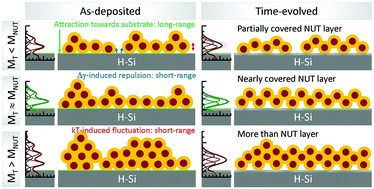Evolution of ligand-capped nanoparticle multilayers toward a near unique thickness†
Abstract
The structural evolution of thiol-capped Au-nanoparticle (AuNP) multilayers on a H-passivated Si substrate, formed through a Langmuir–Schaefer (LS) deposition process, has been investigated using complementary grazing incidence X-ray scattering techniques. The fractional coverage multilayers of AuNPs, formed through a multi-transfer process, are found to be quite unstable under ambient conditions. The thickness of these decreases with time and tends to saturate toward a near unique thickness (NUT ≈ 6 nm). Although initial low coverage and their instability create hindrance in the control and formation of desired 3D-nanostructures in the bottom-up approach, the formation of a NUT-layer, through time-evolution, is quite distinctive, thus interesting. It is clear from the evolution that the thermodynamically driven monolayer structures (of AuNPs) at the air–water interface become thermodynamically unstable when transferred sequentially onto the solid substrate. The thermal energy (kT) and the partial change in the substrate surface energy (Δγ) create the instability and induce diffusion in the AuNPs, which in the presence of a net attractive force towards the substrate (arising from anisotropic interaction of the top AuNPs with the other AuNPs and/or hydrophobic substrate) tries to create a thermodynamically favourable and relatively stable NUT-layer through reorganization for a different duration. This happens if the number of AuNPs is less than or equal to the maximum number that can be accommodated within the NUT. The value of the NUT mainly depends on the particle size and a kT-energy related fluctuation of particles. Furthermore, the formation of the NUT-layer indicates that the hydrophobic–hydrophobic interaction mediated net attraction towards the substrate is long range, while the hydrophilic–hydrophobic interaction mediated repulsion and/or kT-energy induced fluctuations are short range.



 Please wait while we load your content...
Please wait while we load your content...